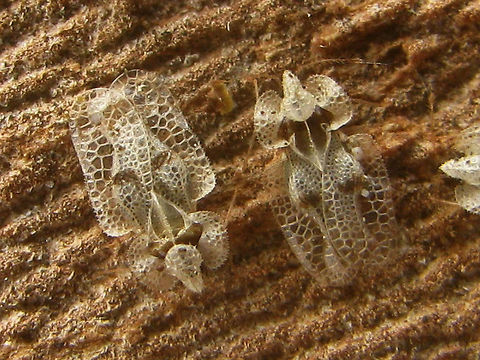
''Corythucha ciliata'', the sycamore lace bug, is a species of lace bug Tingidae that is linked to sycamores in the New and Old Worlds. It is native to the New world.
Similar species: True Bugs
JungleDragon is a nature and wildlife community for photographers, travellers and anyone who loves nature. We're genuine, free, ad-free and beautiful.

''Corythucha ciliata'', the sycamore lace bug, is a species of lace bug Tingidae that is linked to sycamores in the New and Old Worlds. It is native to the New world.
comments (28)
They can be found all year, but will be on the leafs and fruits in spring and summer - out of reach on a decent tree. As they seek out the loose bark to overwinter this is a very easy/good way to spot them. While you're doing so, also look for Arocatus longiceps - same overwintering strategy:
P.S. Oh, yes, and Woodlice and Harvestmen - but those are not insects ;o) Posted 6 years ago, modified 6 years ago
"Lace bugs are inconspicuous, plant feeding insects that are aptly named because the network of veins in their wings resembles lace. They certainly are beautiful bugs, but they can be very destructive to plants. They are usually host-specific and feed on the undersides of leaves by piercing the epidermis and sucking the juices out. When they feed on the liquid in a leaf, they also remove chlorophyll; thus, the afflicted leaves turn white or bronze since it's the chlorophyll that gives leaves their green color. The damage starts out as small dots, called stippling. If prolonged feeding continues, entire leaves and plants can turn brown and die.
Specifically, the Sycamore Lace Bug (Corythucha ciliata) is an important and highly invasive pest. It's native to North America, but has spread to many countries around the world due to human activity. It feeds mainly on sycamore (Platanus sp.) trees. Although it doesn't usually kill the trees that it infests, the bugs are suspected to vector plant-pathogenic fungi, which can kill trees. {Spotted in the Netherlands by JungleDragon moderator, Pudding4brains} #JungleDragon" Posted 6 years ago
Posted 6 years ago
Posted 6 years ago
Arp (aka Pudding4brains) is one of our most beloved moderators and active members on JungleDragon. He specializes on the "unpopular" insects, and his photos consistently remind us that all creatures are unique, fascinating, and beautiful in their own right! Here are five of his most popular photos. Enjoy! #JungleDragon
For more of Arp's photos: https://www.jungledragon.com/user/3043/popular
https://www.facebook.com/jungledragonwildlife Posted 3 years ago, modified 3 years ago